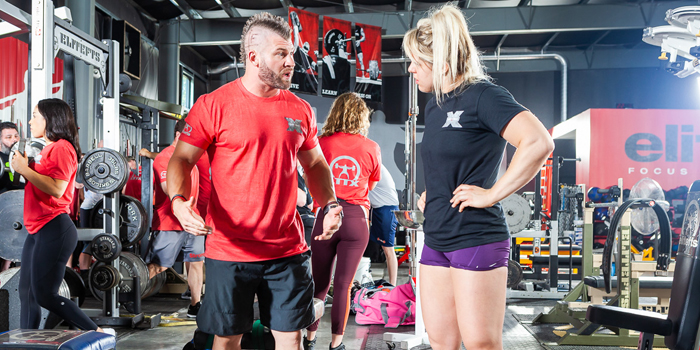
Being a coach and a competitive powerlifter imposes interesting ideas, opinions, and hypotheses into your head when you are transitioning daily between the roles of athlete and coach. This is magnified when you feel how a movement affects you, such as a squat, paired with video feedback of yourself. Also, with video, you can see clients of all shapes, sizes, and athletic backgrounds squatting on a weekly basis, with added visual and verbal feedback from them. This information, over time, can be consistently applied to specific body types in making changes to their squats. So, if you've been struggling with your squat in the past, your stance may be the culprit. Here are a few key points to determine if this is the issue.
Too Wide
When you are TOO WIDE, the body will have some compensatory functions that will come into play. I am going to give some general complaints and visuals to look for.
RECENT: Where Do Powerlifters Go From Here?
"I cannot get to depth" is a good one. Many times this can be a lack of external rotation, so many people just go wider to "cheat" the movement and structurally open up the hip capsule. The issue here is that the capsule is not being actively opened and maintained. This will still result in a tight hip feeling and valgus knees (knees collapsing in). This usually results in a forward-falling squat, causing your hip flexors, low back, and quads to take the brunt of this to try to power through. You may also experience instability in a wide stance because your base of support (although wide) extends laterally—from side to side, not from front to back. As a result, you may feel yourself sway from front to back easily. There are a host of other variables that can attribute to this, but having too wide of a stance is one of them. One of the last common clues that you are too wide in your squat has to do with your feet. If you or your training partner falls onto the inside of the foot, this is a potential flag that he or she is too wide. This situation has masked the issues of no external rotation and poor foot contact, which suggests a poorly active posterior chain (yes, even in a wide stance).
Too Narrow
Moving onto the more popular stance nowadays for competitive lifters and for people in general: narrower stance squats. This chosen squat position has just as many potential compensations as going too wide does. Ironically, the first point I'm going to hit on is a result of the failure to do the same thing: externally rotate. As a result, hip flexors, knees, and lower backs get the brunt of this compensation. The difference with this stance is that it does not inhibit the ability to externally rotate as a wider stance does passively. However, it masks the need for it. Visually, you will see a lifter not hinge as much, and when he or she hits the hole, his or her femurs have nowhere else to go. You will see his or her lower back shift into rounding, allowing the pelvis—which is also the structure in which the hip capsule sits—to rotate around the head of the femur instead of the femur rotating to create space in the hip capsule.
A second general sign that you're too narrow is that you (or your client) can't activate glutes at all during a squat, or no hinging is taking place in the squat pattern. Thus, you're solely on the quads. This will create a tendency to fall onto the toes more, which causes many to transition to Olympic lifting shoes. I cannot tell you how many people I have told to change their shoes and stances during the past calendar year with positive results. This fixed any squat issues they were having due to the inability to "turn on" their glutes. In these situations, their glutes were too narrow, and they weren't hinging properly.
So, there you have it. These are my general suggestions to identify individuals who tend to be too wide or too narrow when it comes to their squats. Stay tuned for the next one, which will go over the five basic cues for squatting that I teach verbatim at all of my seminars.











2 Comments